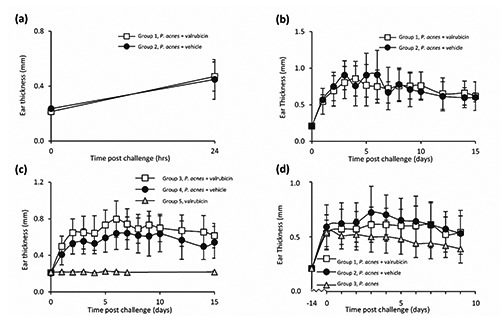Figure 2.

Effect of valrubicin treatment on P. acnes-induced ear inflammation. Ear inflammation was induced in mouse ears by challenging ears with intra-dermal injection of 15 μL (9×107; a and b) or 10 μL (6×107; c and d) freshly prepared P. acnes (clinical strain 1.4.L1). Short term (1 day) topical valrubicin treatment (a): 30 minutes post challenge, ears were treated topically with valrubicin (group 1, n=9) or vehicle (acetone, group 2, n=16). Long term (2 weeks) topical valrubicin treatment (b, c): 30 minutes post challenge and daily hereafter throughout the study, ears were treated topically with valrubicin group 1 (n=7) and group 3 (n=8) or vehicle (acetone) group 2 (n=4) and group 4 (n=8). As control, an additional group of mouse ears (group 5, n=8) was left unchallenged but treated daily with valrubicin throughout the study. Intra-dermal valrubicin treatment (d): 2 weeks post challenge, ears were treated daily for 3 days with central intra-dermal injections of valrubicin (Valstar®) group 1 (n=12) or vehicle (cremophor/ethanol [1:1]) group 2 (n=11). As control, an additional group of challenged ears were left untreated group 3 (n=9). Ear thickness was measured at indicated time points. Values are presented as mean ± standard deviation.
